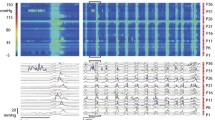Summary
In an attempt to find a non-invasive method yielding a comprehensive insight into a patient's intestinal activity, continuous multichannel registration and analysis of acustic phenomena as produced by the intestines were performed. Previous work, described by others, was further developed with respect to topographical interpretation of the data obtained, and to the possible introduction into general clinical use by installing different methods of artifact detection and reduction.
To record and process bowel sounds, a device developed for this purpose (Phonoenteroanalyzer PEA-06, G-W Elektronik, Munich, FRG) was used. Five specially designed microphones were placed on the abdominal wall. After amplification and filtering, further processing of the signal was achieved by means of rectifying, peak detection, and logarithmic transformation techniques, yielding a topographically discernible pattern of intestinal activity. Noise and movement artifacts, although a basic problem of this technique, could be adequately managed, e.g., by using a control microphone as well as simultaneous registration of breathing.
Ten normal subjects as well as eight patients with manifest or suspected gastrointestinal problems, had their bowel sounds registered either continuously overnight or during adequate stimulatory tests (gastrocolonic response, neostigmine test, rectal distension). Bowel sounds were registrated as short “clicks” or longer lasting, sometimes rhythmically appearing, complex acustic phenomena. Overnight registrations revealed periodical changes in general or local intestinal activity, which in turn showed remarkable interindividual variabilities. Stimulatory tests provoked an enhancement of intestinal activity, which could well be documented with this method.
In conclusion, analysis of acustic phenomena provoked by the bowels should henceforth allow an objective, continuous, long-term, non-invasive, indirect, and at any time repeatable topographical registration of intestinal activity.
Similar content being viewed by others
References
Arnbjörnsson E, Bengmark S (1983) Auscultation of bowel sounds in patients with suspected acute appendicitis — an aid in the diagnosis? Eur Surg Res 15:24–27
Battle WM, Snape WJ, Alavi A, Cohen S, Brunstein S (1980) Colonic dysfunction in diabetes mellitus. Gastroenterology 79:1217–1221
Battle WM, Snape WJ, Wright S, Sullivan MA, Cohen S, Meyers A, Tuthill R (1981) Abnormal colonic motility in progressive systemic sclerosis. Ann Intern Med 94:749–752
Du Plessis DJ (1954) Clinical observation on intestinal motility. S Afr Med J 28:27–33
Glick ME, Meshkinpour H, Halderman S, Bhatia NN, Bradley WE (1982) Colonic dysfunction in multiple sclerosis. Gastroenterology 83:1002–1007
Grafe G (1984) Eignet sich die Phonoenterographie zur Erfassung der postoperativen Darmmotilität? Zentralbl Chir 109:245–253
Heinkelmann W, Hebeler W, Petrowicz O, Duspiva W, Eichmeier J (1977) Die Aufzeichnung von Darmgeräuschen, eine Methode zur kontinuierlichen Registrierung der Darmmotilität. Med Welt 28:895–896
Komarow JA, Jewlew WS, Dubowikow GW (1983) Phonography as an objective method for assessing the peristaltic activity of the intestines. Klin Khir (Kiew) 2:42–43
Snape WJ (1985) Pathophysiology of colonic motility disorders. In: Berk JE (ed) Gastroenterology, 4th edn. Saunders, Philadelphia, London Toronto Mexico City Rio de Janeiro Sydney Tokyo, pp 2407–2416
Snape WJ, Carlson GM, Cohen S (1977) Human colonic myoelectrical activity in response to prostigmine and the gastrointestinal hormones. Dig Dis Sci 22:881–887
Snape WJ, Matarazzo SA, Cohen S (1978) Effect of eating and gastrointestinal hormones on human colonic myoelectrical and motor activity. Gastroenterology 75:373–378
Snape WJ, Wright SH, Battle WM, Cohen S (1979) The gastrocolic response: Evidence for a neural mechanism. Gastroenterology 77:1235–1240
Schuster MM (1985) Tests related to the colon, rectum, and anus. In: Berk JE (ed) Gastroenterology, 4th edn. Saunders, Philadelphia London Toronto Mexico City Rio de Janeiro Sydney Tokyo, pp 388–401
Wright SH, Snape WJ, Battle W, Cohen S, London RL (1980) Effect of dietary components on gastrocolonic response. Am J Physiol 238:G228–232
Author information
Authors and Affiliations
Rights and permissions
About this article
Cite this article
Garner, C.G., Ehrenreich, H. Non-invasive topographic analysis of intestinal activity in man on the basis of acustic phenomena. Res. Exp. Med. 189, 129–140 (1989). https://doi.org/10.1007/BF01851263
Received:
Accepted:
Issue Date:
DOI: https://doi.org/10.1007/BF01851263




